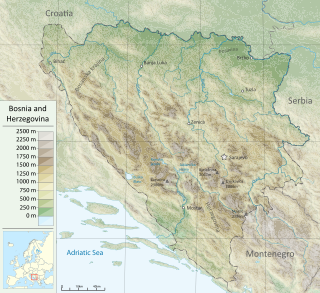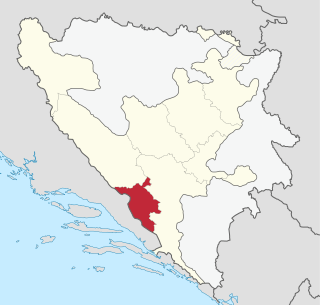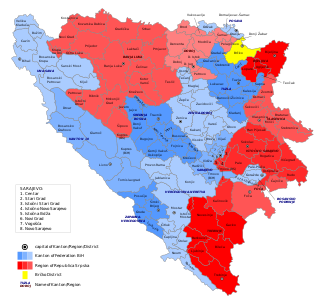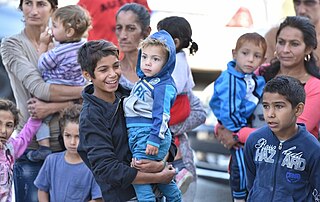
Bosnia and Herzegovina is located in Southeastern Europe. Situated in the western Balkans, it has a 932 km (579 mi) border with Croatia to the north and southwest, a 357 km (222 mi) border with Serbia to the east, and a 249 km (155 mi) border with Montenegro to the southeast. It borders the Adriatic Sea along its 20 km (12 mi) coastline.

The General Framework Agreement for Peace in Bosnia and Herzegovina, also known as the Dayton Agreement or the Dayton Accords, and colloquially known as the Dayton in ex-Yugoslav parlance, is the peace agreement reached at Wright-Patterson Air Force Base near Dayton, Ohio, United States, finalised on 21 November 1995, and formally signed in Paris, on 14 December 1995. These accords put an end to the three-and-a-half-year-long Bosnian War, which was part of the much larger Yugoslav Wars.

The Herzegovina-Neretva Canton is one of 10 cantons of the Federation of Bosnia and Herzegovina in Bosnia and Herzegovina.

The Federation of Bosnia and Herzegovina is one of the two entities composing Bosnia and Herzegovina, the other being Republika Srpska. The Federation of Bosnia and Herzegovina consists of ten autonomous cantons with their own governments and legislatures.

The Bosna is the third longest river in Bosnia and Herzegovina, and is considered one of the country's three major internal rivers, along with the Neretva and the Vrbas. The other three major rivers of Bosnia and Herzegovina are the Una, to the northwest; the Sava, to the north, and the Drina, to the east. This river is the namesake of Bosnia. The river Bosna flows for 282 kilometers (175 mi).

The West Herzegovina Canton is one of the cantons of the Federation of Bosnia and Herzegovina. The West Herzegovina Canton is in the Herzegovina region in the southwest of Bosnia and Herzegovina. Its seat of government is in Široki Brijeg, while other municipalities within the Canton are Grude, Ljubuški and Posušje. It has 94,898 inhabitants, of whom more than 98% are ethnic Croats. Economically, it is the most developed part of Bosnia and Herzegovina.

Podrinje is the Slavic name of the Drina river basin, known in English as the Drina Valley. The Drina basin is shared between Bosnia and Herzegovina and Serbia, with majority of its territory being located in Eastern Bosnia, entire Upper Drina course and majority of the Middle course, while the Lower Drina course is shared between two countries,with the river representing border. The part of the Drina basin located in Bosnia and Herzegovina is also called Eastern Bosnia.

In Bosnia and Herzegovina, the smallest administrative unit is the municipality. Prior to the 1992–95 Bosnian War there were 109 municipalities in what was then Socialist Republic of Bosnia and Herzegovina. Ten of these formed the area of the capital Sarajevo.

The municipal elections of Bosnia and Herzegovina in 1990 were won by several parties. In most municipalities they organized governments in coalitions, or independently if they had a large majority.
Bosnia and Herzegovina, like many countries, is made of geographical, historical, and political regions. The current geopolitical regions were finalised with the signing of the Dayton Agreement.

Our Party is a social-liberal and multi-ethnic political party in Bosnia and Herzegovina, founded in 2008. Its current leader is Edin Forto. The party's founders are the Bosnian directors Danis Tanović and Dino Mustafić. The party aims to break the dominance of nationalist parties in the Bosnian political system. On 4 June 2016, Our Party became a member of the Alliance of Liberals and Democrats for Europe.

The Xoraxane in Bosnia and Herzegovina are the largest of the 17 national minorities in the country, although—due to the stigma attached to the label—this is often not reflected in statistics and censuses.

The 2014 unrest in Bosnia and Herzegovina was a series of demonstrations and riots that began in the northern town of Tuzla on 4 February 2014 but quickly spread to multiple cities in Bosnia and Herzegovina, including Sarajevo, Zenica, Mostar, Jajce, and Brčko, among others, for social reasons and with the aim of overthrowing the government. The riots were the most violent scenes the country had seen since the end of the Bosnian War in 1995. The rioting largely took place in the entity of Federation of Bosnia and Herzegovina, and the same level of unrest or activism did not occur in Republika Srpska.
The 2014–15 Federation of Bosnia and Herzegovina Cup was the qualifying competition for the 2014–15 Bosnia and Herzegovina Football Cup.
The 2015–16 Federation of Bosnia and Herzegovina Cup was the qualifying competition for the 2015–16 Bosnia and Herzegovina Football Cup.
The 10 Cantons of the Federation of Bosnia and Herzegovina are each governed by directly elected parliaments called assemblies. Each assembly is elected by at-large party-list proportional representation with open lists every four years at the same time as federal and entity elections.
Aida Obuća is a Bosnian politician who is the Vice President of SDA and a member of the Federal House of Peoples. She previously served as Prime Minister of the Bosnian-Podrinje Canton Goražde from 2019 to 2022.














